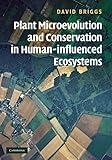Plant microevolution and conservation in human-influenced ecosystems
Material type: TextLanguage: English Publication details: Cambridge : Cambridge University Press, c2009.Description: xix, 598 p. : ill., maps ; 26 cmISBN:
TextLanguage: English Publication details: Cambridge : Cambridge University Press, c2009.Description: xix, 598 p. : ill., maps ; 26 cmISBN: - 9780521818353
- 581.38 BRI
| Item type | Current library | Collection | Call number | Status | Date due | Barcode |
|---|---|---|---|---|---|---|
 Text Books
Text Books
|
CUTN Central Library Sciences | Non-fiction | 581.38 BRI (Browse shelf(Opens below)) | Available | 43587 |
"As human activities are increasingly domesticating the Earth's ecosystems, new selection pressures are acting to produce winners and losers amongst our wildlife. With particular emphasis on plants, Briggs examines the implications of human influences on micro-evolutionary processes in different groups of organisms, including wild, weedy, invasive, feral, and endangered species. Using case studies from around the world, he argues that Darwinian evolution is ongoing. He considers how far it is possible to conserve endangered species and threatened ecosystems through management, and questions the extent to which damaged landscapes and their plant and animal communities can be precisely recreated or restored. Many of Darwin's ideas are highlighted, including his insights into natural selection, speciation, the vulnerability of rare organisms, the impact of invasive species, and the effects of climate change on organisms. An important text for students and researchers of evolution, conservation, climate change and sustainable use of resources." --NHBS Environment Bookstore.
Cover --
Half-title --
Title --
Copyright13; --
Contents --
Preface --
Acknowledgements --
Abbreviations --
1 Introduction --
Human influences: implications for conservation --
Outline of the chapters --
2 Studying change --
Defining terms and questioning assumptions --
Experiments and investigations --
Darwins scientific method --
Advances in the design of experiments --
Elements of experimental design --
Quasi-experiments --
'Proof and falsification --
Testing hypotheses about the past --
Predicting the future --
Weighing the evidence --
Concluding remarks --
3 Key concepts in plant evolution --
Darwins ideas about the evolution of species --
Post-Darwinian contributions to our understanding of evolution --
Cyto-genetic studies --
Chemical basis of hereditary information --
Genetic mutation --
Chromosome changes --
Microevolution in plant populations --
Populations --
Gene flow --
Gene flow and population structure --
Effects of chance in populations --
Stability of natural populations --
Animal and plant interactions --
Plants are different from animals --
Different modes of natural selection --
r- and K-selection --
r-selection --
K-selection --
Fitness --
Neutral theory of selection --
Post-Darwinian models of speciation --
Gradual speciation --
Speciation and founder effects --
Introgressive hybridisation --
Sympatric speciation --
Cytogenetics of polyploidy --
The success of polyploids --
Evidence from the fossil record --
Mass extinctions --
Punctuated equilibrium --
Continental drift --
Orbital variations --
Conclusions --
4 The origin and extent of human-influenced ecosystems --
The origin of humans --
Human uses of plants --
Reaching 5 million: hunter-gatherers --
Reaching 50 million: the beginnings of agriculture --
The process of domestication of plants --
Reaching half a billion: the spread of agriculture from 2000 BC to AD 1500 --
The first billion humans: from subsistence to commercial farming 15001825 --
Populations rising to 2 billion: the expanding frontiers of agriculture 18251927 --
From 2 to over 6.5 billion: the rise of industrial food production 1927 to the present day --
What is the present extent of human-modified ecosystems? --
Human geomorphic activities --
The rise of concern about the environment --
Conservation through protection --
The wise use of resources --
Environmental concerns about pollution --
Atmospheric pollution --
The greenhouse effect and global climate change --
Heavy metal pollution --
Nitrogen (N) compounds --
Phosphate (P) compounds --
Pesticides --
Organic pollutants from various sources --
Concerns about the loss of biodiversity --
Confronting the adverse effects of introduced organisms --
Soil erosion and salination --
The inexorable rise of human populations --
Demographic projections for the next 4050 years --
Ecological footprints --
Conclusions --
5 Consequences of human influences on the biosphere --
Cultural landscapes --
Is there any wilderness left? --
Wilderness concepts --
Wilderness and the 'Pristine Myth --
Megafaunal extinctions --
Cultural landscapes and fire --
How 'virgin is virgin rainforest? --
Wild areas in Europe --
The myth of ocean.
"As human activities are increasingly domesticating the Earth's ecosystems, new selection pressures are acting to produce winners and losers amongst our wildlife. With particular emphasis on plants, Briggs examines the implications of human influences on micro-evolutionary processes in different groups of organisms, including wild, weedy, invasive, feral, and endangered species. Using case studies from around the world, he argues that Darwinian evolution is ongoing. He considers how far it is possible to conserve endangered species and threatened ecosystems through management, and questions the extent to which damaged landscapes and their plant and animal communities can be precisely recreated or restored. Many of Darwin's ideas are highlighted, including his insights into natural selection, speciation, the vulnerability of rare organisms, the impact of invasive species, and the effects of climate change on organisms. An important text for students and researchers of evolution, conservation, climate change and sustainable use of resources."--NHBS Environment Bookstore


There are no comments on this title.